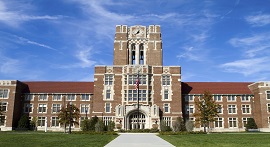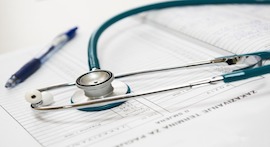Dentistry
Overview
The Doctor of Dental Surgery (D.D.S.) is a four-year degree program designed to train future dentists in the scientific and clinical aspects of the field. Dentistry programs are generally very rigorous, providing students with a thorough introduction to the fundamentals of health sciences and lab work, extensive clinical training, and coursework in critical thinking, problem solving, and ethical issues.
Most D.D.S. programs follow the same general format. The first two years are comprised of pre-clinical coursework in the advanced study of basic biomedical sciences, such as biology, anatomy, and nutrition. While courses cover the entire human health system, they focus on the teeth, gums, mouth, and related bone and tissues. In the last two years of study, students spend the majority of their time in clinical rotations, learning to care for oral health in a variety of environments. Alongside clinical training, students take electives in areas such as endodontics (treatment of disease and injury in the root canal), oral and maxillofacial surgery (the upper and lower jaw and surrounding anatomy), pediatric surgery and pedodontics, orthodontics (corrections of bite abnormalities and facial irregularities), periodontics (treatment of the gums) and prosthodontics (oral implants, bridgework, dentures).
Schools usually do not expect applicants to have undergraduate degrees in pre-dentistry or pre-med studies. In most cases, as long as applicants complete the required prerequisite courses before entering into the program, they should be eligible for admission. In addition to meeting course requirements, students must take the DAT (Dental Aptitude Test), a multiple-choice test on organic chemistry, biology, organic chemistry, comprehension, quantitative reasoning and visual acuity.
Degree Information
There are 55 D.D.S. programs in the United States and 10 in Canada, all of which take roughly four years to complete. After meeting academic and clinical requirements, students are required to pass extensive clinical and written exams in order to graduate. From there, most continue their training in one of the 1,066 dental residency programs.
For students interested in a highly specialized or research-oriented career in dental sciences, several programs offer the Dentist-Scientist Training Program (D.D.S./Ph.D.), which combines the D.D.S. curriculum with extensive research experience. Some schools also offer M.S. and Ph.D. programs in Dental Science, which are generally designed for students who plan to work in dental research. M.S. programs usually require advanced coursework research, lab work, library, and seminar courses.
Questions to Ask Yourself When Choosing a Degree Program
- What electives or specialty programs are offered?
- What educational/professional background do faculty members bring to the program?
- What type of research projects is faculty involved in? Are there research opportunities for students?
- How is clinical time divided? How many different clinical environments are students exposed to?
- Where do students do their clinical work? Are the related clinical facilities of good quality?
- What are the board passing rates for recent graduates?
Career Overview
For those seeking an independent, flexible, and lucrative career in a highly specialized health care field, dentistry is an excellent career choice. Generally speaking, the field is in high demand and dentists are well compensated for their work. Currently, dentists earn within the top 5% of all U.S. professionals.
Most dentists are self-employed, working in private practice. About 80 percent of dentists are generalists, while the remaining 20 percent practice within specialties such as orthodonture or oral/maxillofacial surgery.
On a day-to-day basis, private practice dentists clean teeth, diagnose oral diseases, treat injuries and malformations of the teeth and mouth, and educate patients on dental health and hygiene. They may also perform oral surgery or help people improve their appearance through cosmetic dental work. Because they have a great deal of autonomy and generally high salaries, dentists often spend time engaged in charitable activities in schools or community clinics, providing low cost or free dental care to those in need.
Although most dentists are self-employed, some choose to work in the military, in hospitals, in public health agencies, or in schools as teachers of dental science.
Career/Licensing Requirements
To practice, dentists must meet educational requirements and pass their state board tests administered by the American Association of Dental Examiners.
Salary Information
Practicing dentists with several years of experience can expect to earn $100,000 or more. Those just starting out in the field can expect to earn less than that, especially if they are buying into an existing practice.
Related Links
American Dental Association
The American Dental Association has news, information on education and licensure, professional research, educational materials, publications, legal news, and much more.
American Student Dental Association
The American Student Dental Association is a student-run organization, dedicated to protecting the rights and interests of dental students.
American Dental Education Association
The American Dental Education Association aims to promote education and awareness of dental health issues in the United States. Check their website for news and membership information, as well as a directory of U.S. and Canadian dental schools.
Pre-Dental Society
The Pre-Dental Society is a network of students preparing for advanced level training as dentists or in dental science.
VIEW ALL Dentistry SCHOOLS BY PROGRAM
RELATED GRADUATE PROGRAMS
SAMPLE CURRICULUM
Dental Anatomy
Advanced Clinical Diagnosis
Anatomy
Dental Materials
Development, Structure, & Function Of Oral Tissues
Endodontics
General & Systemic Pathology
General Pharmacology
Head And Neck Anatomy
Human Physiology
Introduction To Endodontics
Introduction To Nervous System
Local Anesthesia
Molecular Microbiology & Oral Diseases
Operative Dentistry
Oral Biology
Oral Disease
Oral Medicine
Oral Pathology
Oral Radiology
Oral Surgery
Orthodontic Diagnosis And Treatment
Orthodontics
Physical Diagnosis
Prevention/Periodontics
Restorative Dentistry
Featured MBA Programs For You
Connect with business schools around the globe and explore your MBA options.

Best Business Schools
Check out our lists of best on-campus and online MBA programs and find the best program for your career goals.
Explore Graduate Programs For You
Ranked master’s programs around the globe are seeking students like you to join their programs.
Med School Advice
Get medical school application advice, USMLE prep help, learn what to expect in med school and more.


